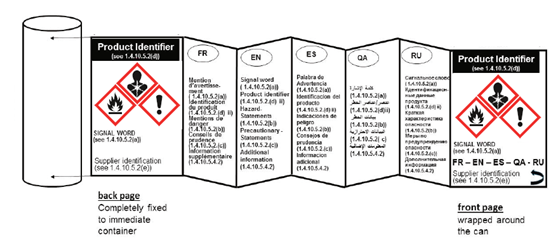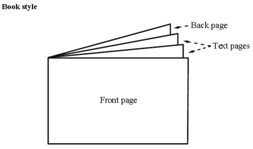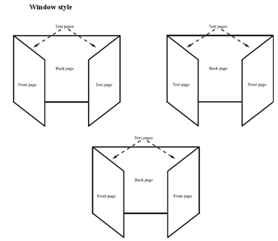Updated on 18 September 2017
UN GHS refers to the Globally Harmonized System of Classification and Labelling of Chemicals (purple book). It is an international system created by United Nations Committee of Experts on GHS, International Labor Organization (ILO) and the Organization for Economic Co-operation and Development (OECD) to address the classification of chemicals by types of hazards and harmonize hazard communication elements, including labels and safety data sheets. It aims at providing a basis for harmonization of rules and regulations on chemicals at national, regional and worldwide level, meanwhile, trade facilitation is also an important factor. GHS has been introduced to many countries/regions such as Europe, USA, China, Japan and Korea, etc via their own legislation or standards. It is now considered as one of the most important regulations for the import and export of hazardous chemicals around the world.
The UN GHS 1st edition was released in 2003. From then on, United Nations Committee of Experts on GHS meets regularly to discuss the update of UN GHS and releases a revised GHS edition every two years. In July 2017, the 7th revised edition was formally released. Compared with the 6th revised edition, the 7th revised edition is amended in the following aspects:
1. Definitions and Acronyms
- Deleted definitions of dermal corrosion, dermal irritation, eye irritation, serious eye damage, skin corrosion and skin irritation in Chapter 1.2
- In the definition of skin sensitizer, replaced “a substance” with “a substance or mixture”.
2. Transfer of Hazard Communication: SDS
- For the hazard class “aspiration hazard” in table 1.5.1, the cut-off value/concentration limit of categories 1 and 2 was updated and the condition of kinematic viscosity was deleted. Details are shown as follows:
| 6th Revised Edition | 7th Revised Edition |
Aspiration hazard (category 1) | ≥10% of category ingredients, kinematic viscosity ≤ 20.5 mm2/s at 40°C. | ≥1.0% |
Aspiration hazard (category 2) | ≥10% of category ingredients, kinematic viscosity ≤14 mm2/s at 40°C. | ≥1.0 |
- Information concerning the ILO standards under the Recommendation 177 on “Safety in the use of chemicals at work”, ISO 11014 of the International Standard Organization (ISO), the European Union Safety Data Sheet Directive 91/155/EEC and the American National Standard Institute (ANSI) standard Z 400.1 in 1.5.3.3.3 was deleted.
3. Addition of New Classification Criteria under Flammable Gases and Updates of Criteria for Categorization
- The 7th Revised Edition integrated the Table 2.2.1, 2.2.2 and 2.2.3 in the 6th revised edition; A flammable gas is classified in 1A, 1B or 2 and flammable gases that are pyrophoric and/or chemically unstable are always classified in Category 1A
- The criteria for categorization of flammable gas (category 1B) was added: Gases which meet the flammablility criteria for category 1A, but which are not pyrophoric, nor chemically unstable, and which have at least either (a) a lower flammability limit of more than 6% by volume in air; or (b) a fundamental burning velocity of less than 10 cm/s)
- Note 3 was newly added: In the absence of data allowing classification into Category 1B, a flammable gas that meets the criteria for Category 1A is classified per default in Category 1A.
- Table 2.2.3.1 amended and added corresponding signal words, pictograms and hazard statements.
- Added the determination method of burning velocity of flammable gases (ISO817: 2014 Annex C) in paragraph 2.2.4.2.1;
- Amended the parameters for the calculation of a flammable gas mixture.
1. The equivalency factors (Ki) for the inert gases versus nitrogen were revised as Ki(Ar)=0.55, Ki(He)=0.9;
2. The Tci coefficients for the flammable gases were revised as Tci H2=5.5%, Tci CH4=8.7%.
4. Update of the Classification Criteria for Flammable Solids
- Amended the end of paragraph 2.7.2.2 to read as follows: …and the reaction spreads over the whole length of the sample (100mm) in 10 minutes or less.
5. Amendment of the Definition and Classification Criteria for Acute Toxicity
- In paragraph 3.1.1, definition of acute toxicity was changed as: serious adverse health effects (i.e., lethality) occurring after a single or short term oral, dermal and inhalation exposure to a substance or mixture.
- Amended the classification criteria. In paragraph 3.1.2.1, inserted the sentence “while some in vivo methods (e.g. using fewer animals) determine LD50/LC50 values directly, other newer in vivo methods consider other indicators of acute toxicity, such as significant clinical signs of toxicity, which are used by reference to assign hazard category”.
- In Table 3.1.1 the ATE values were revised from maximum value to range value.
- The paragraph 3.1.2.3 added the consideration approaches and principles in cases where data from human experiences: In cases where data from human experiences (i.e. occupational data, data from accident databases, epidemiology studies, clinical reports) are also available, they should be considered in a weight of evidence approach consistent with the principles described in 1.3.2.4.9.
6. Update of the Definition of Skin Corrosion/Irritation
- The 7th revised edition deleted the 4-hour time limit. Definitions of skin corrosion/irritation were revised as follows:
- Skin corrosion: The production of irreversible damage to the skin; namely, visible necrosis through the epidermis and into the dermis occurring after exposure to a substance or mixture.
- Skin irritation: The production of reversible damage to the skin after exposure to a substance or mixture.
7. Update of the Definition of Serious Eye Damage/Eye Irritation
- The 7th revised edition deleted the 21-day observation period. Definitions of serious eye damage/eye irritation were revised as follows:
- Serious eye damage: The production of tissue damage in the eye or serious physical decay of vision, which is not fully reversible, occurring after exposure of the eye to a substance or mixture.
- Serious eye irritation: The production of changes in the eye, which are fully reversible, occurring after exposure of the eye to a substance or mixture.
8. Update of the Definition of Respiratory or Skin Sensitization
- In the 7th revised edition, mixtures were also defined as respiratory/skin sensitizer.
9. Update of the Definition of Germ Cell Mutagenicity
- Added the definition of germ cell mutagenicity: Germ cell mutagenicity refers to heritable gene mutations, including heritable structural and numerical chromosome aberrations in germ cell occurring after exposure to a substance or mixture.
10. Amendment of the Annexes
- As the classification of flammable gases was updated, the corresponding information in Table A1.2 was revised as well.
- Codification and use of precautionary statements in Annex 3 were extensively updated, which includes:
Added part:
- P103 should be omitted where P202 is used;
- For consumer products, P201 should be omitted where P202 is used;
- P202 inserted a new row for the hazard class “reproductive toxicity, effects on or via lactation”, hazard category “additional category”);
- For the hazard class acute toxicity oral category 5, added precautionary codes P301 and P301+P312;
- P332 may be omitted where P333 is used;
- For the hazard class desensitized explosives category 4, added precautionary code P375;
- For acute toxicity inhalation category 3, added precautionary code P501; and
- Inserted a new precautionary statement P503: Refer to manufacturer / supplier /… for information on disposal / recovery / recycling; applicable for explosives - unstable explosives and Divisions 1.1, 1.2, 1.3, 1.4, 1.5.
Deleted part:
- For precautionary code P231+P232, deleted hazard class pyrophoric liquids and pyrophoric solids;
- Use of precautionary statements:
- Paragraph A3.3.1.6,A3.3.1.7 and A3.3.1.8 were added in A3.3.1.They respectively focused on the workplace training on occupational health and safety procedures; addition of information based on the composition of products, information shown on the container, label and safety data sheets; and that protective effect of pictogram is limited and pictogram is not a substitute of training.
- A3.3.2 was discussed in details in four aspects in the 7th revised edition. They are: omission of precautionary statements where the advice is not relevant, combination or consolidation of precautionary statements; variation of texts not affecting the safety message; and the application of precautionary statements concerning medical response
- Added 3.3.4.1 in the 7th revised edition. If the products are consumer products, the general precautionary statements listed in Table 3.2.1 should also be labeled on the GHS label.
- Update of SDS preparation guidance
- In Table 4.3.9.2, added a test method ISO817:2014, Annex C, to determine the fundamental burning velocity if the gas is classified as flammable gases category 1B;
- In A4.3.14.7, discussed the transport in bulk in details, including the liquid bulk cargos, solid bulk cargos and liquefied gas cargos.
- A new example for fold-out labels of small containers was added.

Fold-out labels include front page, text page and back page. The front page should contain at least: product identifier, hazard pictogram(s), signal word and supplier identification. A symbol to inform the user that the label can be opened to illustrate that additional information is available on inside pages is also required. The text page should contain: product identifier (including hazardous components contributing to the classification), signal word, hazard statements, precautionary statements and other information (such as directions for use and information required by other regulations). If more than one language is used on the fold-out label, the country codes or language codes are required. The back page should contain: product identifier, hazard pictogram(s), signal word and supplier identification.
Additionally, there are different fold-out labels styles, e.g. book style, order book style and window style.



Comments:
The 7th revised edition amended the classification criteria for flammable gases, which makes it stricter and easier for understanding; updated the definitions of some health hazards, such as acute toxicity, skin corrosion/irritation and serious eye damage/eye irritation, mainly called off the specific requirements for exposure time or symptom observation time. The use and preparation of precautionary statements were amended. Besides, the latest GHS also added a new example of fold-out labels for small containers. In this way, even if the container is small, the large number of hazard statements assigned to the chemical can be placed on the label.
Currently, GHS implemented in China aligns with the UN GHS 4th revised edition. As the result, the release of the latest GHS will not affect imported products. However, as some countries that have already implemented GHS may also amend relevant GHS regulations and standards to align with the 7th revised edition. CIRS warmly reminds that enterprises exporting products to other countries should pay close attention to the GHS systems of the exporting countries.
If you have any other questions, please contact us at service@cirs-group.com.

